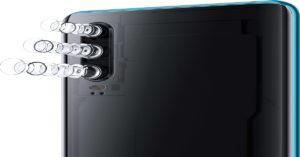Camera
Xiaomi’s Mi 9 sports a triple-rear camera setup that comprises of a 48MP Sony IMX586 image sensor with an f/1.75 aperture paired with a 12MP telephoto lens with an f/2.2 aperture and a 16MP ultra wide-angle lens with an f/2.2 aperture. The camera of the Mi 9 supports macro, wide-angle photography along with laser focus, phase detection focus and contrast detection focus. At the front, the Mi 9 has a 20MP camera with an f/2.0 aperture. On the other hand, Huawei P30 comes with Leica triple-rear camera setup with a 40MP Super Sensing wide angle lens with an f/1.8 aperture paired with a 16MP ultra wide-angle lens with an f/2.2 aperture and an 8MP telephoto lens with an f/2.4 aperture. Although less in terms of resolution, Huawei P30 comes supports laser focus, phase focus, contrast focus along with AIS (Huawei AI Image Stabilization) and has support for 3X optical zoom and 5X hybrid zoom. The device comes with Laser Transmitter and Laser Receiver for an improved focus and has a feature called SuperSpectrum Sensor that enables and ISO rating of 204,800.
Furthermore, Mi 9 packs a 20MP Beautify selfie camera, while Huawei P30 has a 32MP front facing snapper with AI HDR+ support. So, in terms of camera capabilities, Huawei P30 clearly wins even though it’s lesser in terms of resolution. We should remind you that resolution in camera isn’t everything, but features are. Even Google Pixel 3 packs a 12.2MP rear camera, but it comes with so many features that it makes it one among the best that are there.
Processor
Xiaomi’s Mi 9 is powered by Qualcomm’s Snapdragon 855 processor, which is the most powerful mobile chip in the world. Huawei P30, on the other hand, runs on the company’s own Kirin 980 SoC, which is the most powerful one by the Chinese smartphone brand yet. In this, we have to say that Xiaomi wins.
Do you think a flagship smartphone should cost you a fortune? #Mi9 pic.twitter.com/g0ufXOeYA4 — Xiaomi (@Xiaomi) March 26, 2019
Display
While Mi 9 comes with 6.39-inch Samsung’s AMOLED FHD+ (2340 x 1080 pixels) display with 403ppi, the Huawei P30 comes with 6.1-inch FHD+ (2340 x 1080 pixels) Wide Color Gamut OLED display with 398ppi. We should point out here that even though Mi 9’s screen size is more, Huawei P30 has an OLED display, which is the same as iPhone XS and iPhone XS Max’s. However, it should be noted that the Mi 9 comes with Gorilla Glass 6 protection which the Huawei P30 lacks. As far as display goes, it comes down to what you prefer. Some may opt for Mi 9’s slightly taller display, but personally, we would opt for an OLED screen.
Battery
The Mi 9 packs a 3,300mAh with QuickCharge v4.0 and wireless charge support while the Huawei P30 comes with 3,650mAh battery with 40W SuperCharge support. However, it cannot be charged wirelessly.
IP rating
The Mi 9 doesn’t come with any IP rating which makes it susceptible to rain, dust and water damage but the Huawei P30 comes with IP53 rating making the device splash and dust resistant.
RAM and Storage
Both the devices come with 6GB RAM/128GB storage as the base variants. However, Huawei P30 has another variant with 8GB RAM. The Huawei P30 also comes with nano-memory card support of up to 256GB, which the Mi 9 lacks.
Honorable mention: OneHop
Huawei P30 has a very interesting and useful feature called OneHop, which enables users to send photos, videos and documents to Huawei Matebook just by tapping the smartphone on the laptop. This feature also allows the Huawei Matebook to start recording a 60 seconds video of the laptop screen just by shaking and touching the P30 with the Matebook. Copied texts can also be pasted between the devices easily.
Conclusion
Xiaomi’s Mi 9 is price lower than the Huawei P30 which is a big point for the company but there are additional features in the Huawei P30, which the Mi 9 lacks. So even though it’s costlier, we would say that Huawei P30 is worth the money for someone who would want the extra camera features, or a better display experience for watching your favourite shows. Furthermore, we must add here that Xiaomi devices may charge less, but they are also full of bloatware and ads that you can’t get rid of. So, if you are someone who would want to avoid getting annoyed with them, you may want to throw in some extra bucks to buy the Huawei P30 instead. For the latest gadget and tech news, and gadget reviews, follow us on Twitter, Facebook and Instagram. For newest tech & gadget videos subscribe to our YouTube Channel. You can also stay up to date using the Gadget Bridge Android App.








